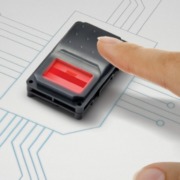In the world of access control, biometric technologies are playing an increasingly important role. Two leading approaches stand out: facial recognition and fingerprint scanning. Each has its specific advantages and preferred use cases. Biotime is here to help you make the right choice.
Facial recognition: contactless access control
Facial recognition authenticates individuals by analyzing facial features. This technology relies on embedded algorithms capable of verifying identity in a fraction of a second, even in complex situations. The contactless nature is a key benefit, especially in environments sensitive to hygiene or user comfort concerns.
This solution is particularly suited to companies looking to streamline access points, reduce queues, or automate frequent entries. A well-positioned biometric reader like IDEMIA’s VisionPass can recognize a face in motion, with or without a mask, under various lighting conditions.
However, its performance depends on hardware quality, viewing angle, and the immediate environment. Poor lighting or poorly managed crowd flow may hinder the user experience.
Fingerprint scanning: the traditional biometric solution still going strong
While older, fingerprint technology remains widely used. It works by capturing the unique points of one or more fingers. Historically the most deployed biometric method, it continues to appeal due to its reliability and ease of use.
It offers a high level of security for individual or moderately trafficked access points, such as office doors, technical rooms, or restricted zones. Equipment costs are typically lower than facial recognition terminals, making it a cost-effective option for certain projects.
Its main drawback is the need for physical contact. Moist, dirty, or damaged fingers can result in slower or failed recognition. And in high-traffic areas, consecutive fingerprint scans can slow down entry flow.
Choosing the right solution depends on your environment
Facial recognition and fingerprint scanning are both effective solutions, but they meet different needs. The best choice depends on the location, number of users, security requirements, and frequency of access.
At Biotime, we offer high-performance biometric terminals, including IDEMIA and HID products, fully compatible with a wide range of access control platforms.
Our devices are available in stock and can be delivered quickly, backed by local technical support.
Still unsure which technology is best for you or need to check compatibility? Get in touch with our team for fast, solution-oriented advice.






